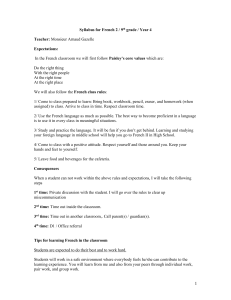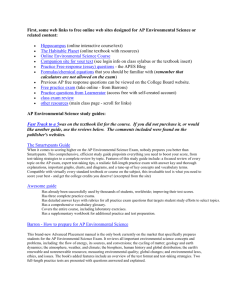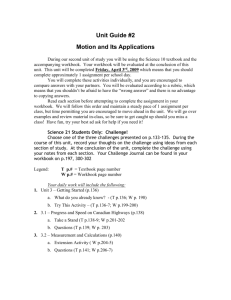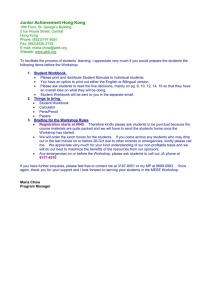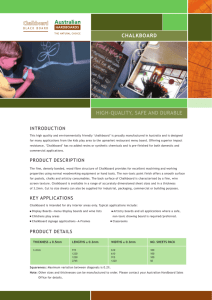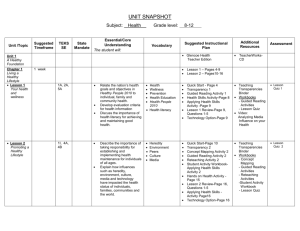Terminology
advertisement
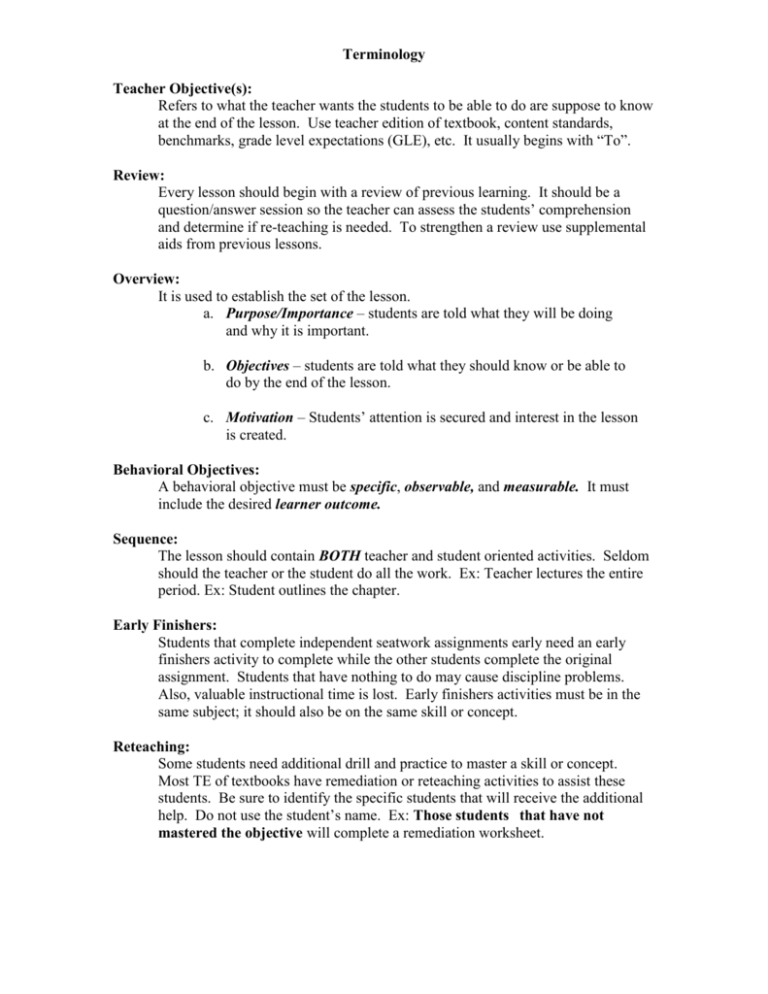
Terminology Teacher Objective(s): Refers to what the teacher wants the students to be able to do are suppose to know at the end of the lesson. Use teacher edition of textbook, content standards, benchmarks, grade level expectations (GLE), etc. It usually begins with “To”. Review: Every lesson should begin with a review of previous learning. It should be a question/answer session so the teacher can assess the students’ comprehension and determine if re-teaching is needed. To strengthen a review use supplemental aids from previous lessons. Overview: It is used to establish the set of the lesson. a. Purpose/Importance – students are told what they will be doing and why it is important. b. Objectives – students are told what they should know or be able to do by the end of the lesson. c. Motivation – Students’ attention is secured and interest in the lesson is created. Behavioral Objectives: A behavioral objective must be specific, observable, and measurable. It must include the desired learner outcome. Sequence: The lesson should contain BOTH teacher and student oriented activities. Seldom should the teacher or the student do all the work. Ex: Teacher lectures the entire period. Ex: Student outlines the chapter. Early Finishers: Students that complete independent seatwork assignments early need an early finishers activity to complete while the other students complete the original assignment. Students that have nothing to do may cause discipline problems. Also, valuable instructional time is lost. Early finishers activities must be in the same subject; it should also be on the same skill or concept. Reteaching: Some students need additional drill and practice to master a skill or concept. Most TE of textbooks have remediation or reteaching activities to assist these students. Be sure to identify the specific students that will receive the additional help. Do not use the student’s name. Ex: Those students that have not mastered the objective will complete a remediation worksheet. Enrichment: Some students will master the skill or concept more quickly than the average student. These students need to be challenged or they will become bored. The enrichment activity needs to be at a higher order thinking skill level than the original activity. The TE of the textbook will usually provide enrichment activities. Be sure to identify these students without using the student’s names: Ex: Those students that have mastered the objective will write a paragraph expressing his/her opinion on the new constitutional amendment. Special Needs: This category includes the students with special needs. There are many possibilities; each class of students will differ. Some of these needs include visually impaired, hearing impaired, physically handicapped, learning disabled, etc. You must identify the need of the student and how you plan to accommodate the need. Do not use the student’s name. You may need to identify more than one special need depending on your class. Ex: My legally blind student will receive enlarged copies of the handout. Ex: My learning disabled student will have the test administered in the resource room by the resource teacher. Ex: My slow student will be given additional time to complete the assignment. Ex: My hearing impaired student will sit closer to the front of the room. Closure: A formal closure to the lesson is a must. It may be a summary of the lesson given by the teacher. Ex: To close today’s lesson let me summarize what we have learned. It may be a question and answer session led by the teacher. Ex: To close today’s lesson let’s review what we have learned. Note: This is a better closure than the summary because the teacher can determine from the students’ responses if reteaching is needed in the next day’s lesson. A closure may be a restatement of the lesson’s objectives in the past tense. Ex: To close today’s lesson let’s see what you should now be able to do. Homework: ● Assignments should be written on board. ● Students should be given an opportunity to copy the assignment. ● Directions should be thoroughly explained. Ex: Use ink to complete the assignment. Ex: The assignment will be handed in for a grade. ● Use complete sentences to write the answers to the questions, etc. ● If possible, demonstrate what is expected of the students by working an example. ● Ask students if there are any questions. Reflective Comments: ● Use complete sentences and black ink to write reflective comments. ● Write 5-7 sentences that are specific, meaningful, and useful. ● What worked? Why did it work? ● What didn’t work? Why didn’t it work? ●What would you do the same if you were to teach the same lesson again? ● What would you do differently? Aids/Materials Column Aid: Teaching aid is used by the teacher to present the content of the lesson. (A) = aid Ex: chalkboard, textbook, write-on transparencies used in place of the chalkboard, workbook or workbook pages Supplemental Aid: Additional aids used by the teacher to present content. (SA) = supplemental aid Ex: prepared transparencies, charts, models, computer, poems, newspaper, VCR, 16 mm film, filmstrip, cassettes, etc. A supplemental aid is anything used by the teacher other than the text and chalkboard and workbook/workbook pages. Material: Standard materials used by the student (M) = material Ex: textbook, chalkboard, workbook, workbook pages, study guides, etc. Supplemental Materials: Additional materials provided for the student and prepared by the teacher to enhance learning. (SM)= supplemental material Ex: diagrams, manipulatives, maps, calculators, etc. ASSESSMENT: There are two main types of assessment. 1. INFORMAL ASSESSMENT: No grade is given. The teacher is checking for student comprehension. Ex: Observation of body language such as facial expressions, signs of frustration, confusion, etc., monitoring of seatwork, written feedback or oral responses, checklists, etc. 2. FORMAL ASSESSMENT: A grade is recorded. There are two types of formal assessment: a. Formative assessment: Daily grades are given to check for student progress. A formative grade is usually less than 100 points. Ex: quizzes, class participation, written seatwork assignments, projects, reports, journal writings, etc. b. Summative assessment: A summary test is given. It is usually 100 points. Ex: chapter test, unit tests, 6 week test, term paper, etc. GROUP SIZES: Large: The class is participating as a group. Ex: class discussion Ex: students are taking notes. Small: Two or more students are working together. Ex: cooperative learning groups. Independent: Students working at their desks. Technology: “Any electronic tool used for solving problems, communicating clearly, processing information, increasing productivity, accomplishing a task, making informal decisions, and enhancing the quality of life.” (Louisiana State Department of Education) Alignment: “The consistency among objectives, pre-assessments, instruction, and post-assessments.” (Louisiana State Department of Education) Artifacts: “Documents or pieces of evidence that are used to support portfolio entries. Good artifacts should demonstrate the active thought processes of student, not the ability to recall facts.” (Louisiana State Department of Education) Teaching Portfolio: “A collection of documents that tell the story of teaching as it develops over a period of time. The documents become evidence that reflect the teacher’s understanding and ability to effectively teach. The portfolio is a way to document not only what the teacher and students say and do, but it is also a reflection of the teacher’s thinking, decision-making, and professional development.” (Louisiana State Department of Education) Work Sample: “A one-to six-week body or unit of instruction focusing on one subject area for a group of students. The content of a Work Sample usually includes: a description of the classroom context and the students being taught; the plans for instruction and assignment aligned with the learning outcomes desired; the teaching of the content; and the collection, interpretation, and reflection on evidence of student progress. The Work Sample represents the first entry in The Louisiana New Teacher Portfolio.”
